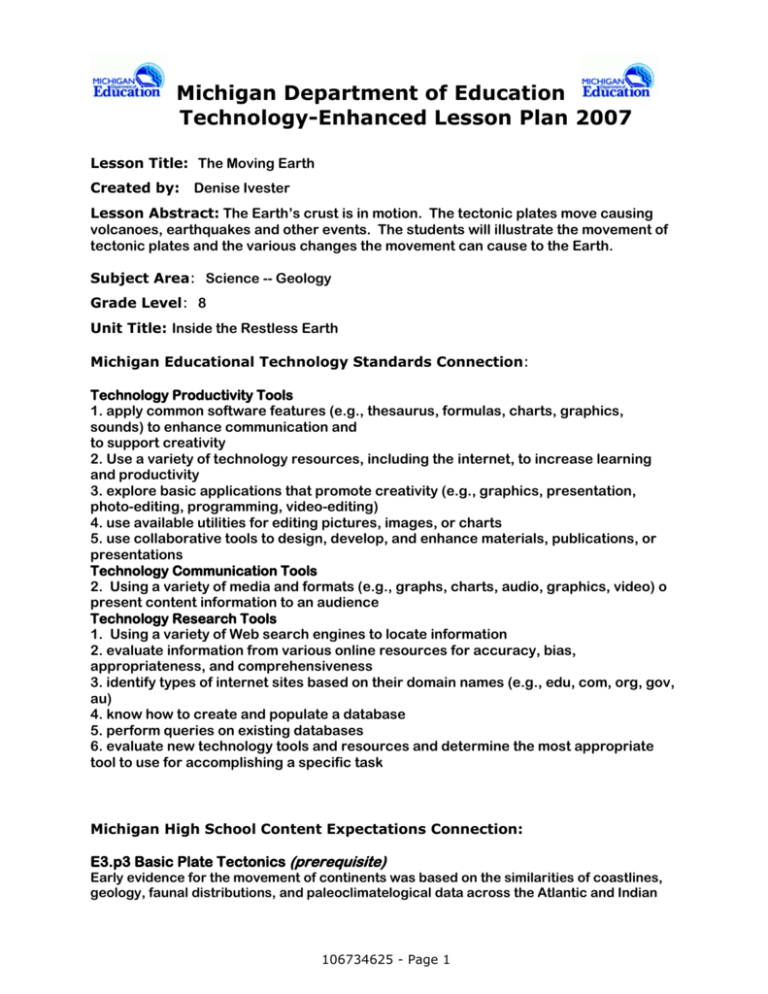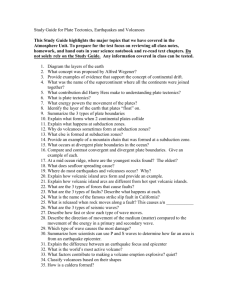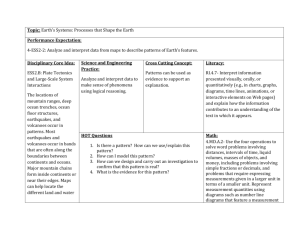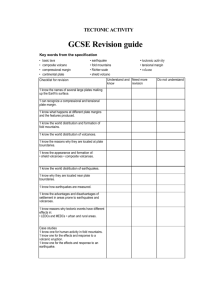Moving Earth - Michigan Department of Education Technology
advertisement

Michigan Department of Education Technology-Enhanced Lesson Plan 2007 Lesson Title: The Moving Earth Created by: Denise Ivester Lesson Abstract: The Earth’s crust is in motion. The tectonic plates move causing volcanoes, earthquakes and other events. The students will illustrate the movement of tectonic plates and the various changes the movement can cause to the Earth. Subject Area: Science -- Geology Grade Level: 8 Unit Title: Inside the Restless Earth Michigan Educational Technology Standards Connection: Technology Productivity Tools 1. apply common software features (e.g., thesaurus, formulas, charts, graphics, sounds) to enhance communication and to support creativity 2. Use a variety of technology resources, including the internet, to increase learning and productivity 3. explore basic applications that promote creativity (e.g., graphics, presentation, photo-editing, programming, video-editing) 4. use available utilities for editing pictures, images, or charts 5. use collaborative tools to design, develop, and enhance materials, publications, or presentations Technology Communication Tools 2. Using a variety of media and formats (e.g., graphs, charts, audio, graphics, video) o present content information to an audience Technology Research Tools 1. Using a variety of Web search engines to locate information 2. evaluate information from various online resources for accuracy, bias, appropriateness, and comprehensiveness 3. identify types of internet sites based on their domain names (e.g., edu, com, org, gov, au) 4. know how to create and populate a database 5. perform queries on existing databases 6. evaluate new technology tools and resources and determine the most appropriate tool to use for accomplishing a specific task Michigan High School Content Expectations Connection: E3.p3 Basic Plate Tectonics (prerequisite) Early evidence for the movement of continents was based on the similarities of coastlines, geology, faunal distributions, and paleoclimatelogical data across the Atlantic and Indian 106734625 - Page 1 Oceans. In the 1960s, additional evidence from marine geophysical surveys, seismology, volcanology, and paleomagnetism resulted in the development of the theory of plate tectonics. (prerequisite) E3.p3B Describe the three types of plate boundaries (divergent, convergent, and transform) and geographic features associated with them (e.g., continental rifts and midocean ridges, volcanic and island arcs, deep-sea trenches, transform faults). E3.p3C Describe the three major types of volcanoes (shield volcano, stratovolcano, and cinder cones) and their relationship to the Ring of Fire. E3.3 Plate Tectonics Theory The Earth’s crust and upper mantle make up the lithosphere, which is broken into large mobile pieces called tectonic plates. The plates move at velocities in units of centimeters per year as measured using the global positioning system (GPS). Motion histories are determined with calculations that relate rate, time, and distance of offset geologic features. Oceanic plates are created at mid-ocean ridges by magmatic activity and cooled until they sink back into the Earth at subduction zones. At some localities, plates slide by each other. Mountain belts are formed both by continental collision and as a result of subduction. The outward flow of heat from Earth’s interior provides the driving energy for plate tectonics. E3.3A Explain how plate tectonics accounts for the features and processes (sea floor spreading, mid-ocean ridges, subduction zones, earthquakes and volcanoes, mountain ranges) that occur on or near the Earth’s surface. E3.3B Explain why tectonic plates move using the concept of heat flowing through mantle convection, coupled with the cooling and sinking of aging ocean plates that result from their increased density. E3.3C Describe the motion history of geologic features (e.g., plates, Hawaii) using equations relating rate, time, and distance. E3.3d Distinguish plate boundaries by the pattern of depth and magnitude of earthquakes. E3.r3e Predict the temperature distribution in the lithosphere as a function of distance from the mid-ocean ridge and how it relates to ocean depth. (recommended) E3.r3f Describe how the direction and rate of movement for the North American plate has affected the local climate over the last 600 million years. (recommended) E3.4 Earthquakes and Volcanoes Plate motions result in potentially catastrophic events (earthquakes, volcanoes, tsunamis, mass wasting) that affect humanity. The intensity of volcanic eruptions is controlled by the chemistry and properties of the magma. Earthquakes are the result of abrupt movements of the Earth. They generate energy in the form of body and surface waves. E3.4A Use the distribution of earthquakes and volcanoes to locate and determine the types of plate boundaries. E3.4B Describe how the sizes of earthquakes and volcanoes are measured or characterized. E3.4C Describe the effects of earthquakes and volcanic eruptions on humans. E3.4d Explain how the chemical composition of magmas relates to plate tectonics and affects the geometry, structure, and explosivity of volcanoes. E3.4e Explain how volcanoes change the atmosphere, hydrosphere, and other Earth systems. E3.4f Explain why fences are offset after an earthquake, using the elastic rebound theory. Estimated time required to complete lesson or unit: Five forty-nine minute class periods 106734625 - Page 2 Instructional resources: Textbook trade books on the topics of plate tectonics, earthquakes, and volcanoes, Internet Animation software Prior required technology skills: A basic knowledge of the animation software will be helpful, but that skill will be taught to those that do not know how to use the software. Most students at this level can use the software without assistance, but a few will need to be taught the basics in order to be successful. Sequence of Activities: The students will work in groups of two to three to construct a short animated presentation that will illustrate the movement of tectonic plates and the various catastrophic events that occur on Earth. Assessments: Pre-Assessment: The students will complete a See, Think, Wonder after viewing several photos of the aftermath of catastrophic events. o Scoring Criteria: The charts will be scored on a 4 point rubric based on the depth the students uses in his/her analysis. Post-Assessment: The presentation will be scored using a teacher made rubric. o Scoring Criteria: Name ___________________ Group Members_________________________ Title: ___________________________________ Animation shows a clear understanding of content Required concepts included Creativity Credits slide included 20 points 10 points 5 points 5 points Technology (hardware/software): Computers, animation software Key Vocabulary: crust, mantle, core, lithosphere, asthenosphere, mesosphere, outer core, inner core, tectonic plate, continental drift, sea-floor spreading, Pangaea, plate tectonics, convergent boundary, subduction zone, divergent boundary, transform boundary, stress compression, tension, folding, fault, normal fault, reverse fault, stikeslip fault, seismology, deformation, elastic rebound, seismic waves, P waves, S waves, seismograph, seismogram, epicenter, focus, seismic gap, volcano, lava pyroclastic material, shield volcano, cinder cone volcano, composite volcano, crater, caldera, rift, hot spot Application Beyond School: These events affect all humans due to the changes in the Earth and its atmosphere. 106734625 - Page 3 UDL Connections (insert in sections where applicable) Recognition networks, strategic networks, affective networks Teacher Reflection and Notes: 106734625 - Page 4








